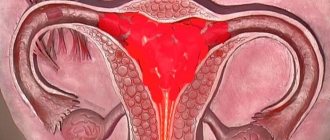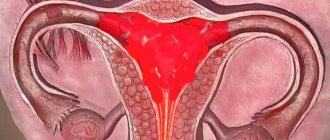Not every woman is lucky enough to conceive a child immediately after stopping all contraceptives used. For some, even after a year of trying, happiness still did not smile. And then the doctor makes a diagnosis - infertility, which greatly upsets the young couple. And the search for the problem begins.
Often the cause is a problem in the fallopian tubes, through which the fertilized egg must travel when it meets the sperm. An obstacle on the way may be a cyst in the fallopian tube. We will talk about this and everything related to the female reproductive system in this article.
Characteristics
A paratubal neoplasm is a cavity, the enlargement of which occurs when it is filled with fluid.
Its characteristic feature, which distinguishes it from similar formations, is the inability to modify normal tissue cells lining the cyst shell into a malignant state, that is, the inability to malignize and degenerate into a tumor.
A paratubar cyst can occur on the right and left ovaries; it has a round shape in the form of a single chamber filled with light liquid. Its size is also varied: it can be quite large and takes up a significant space in the abdominal cavity and in the pelvic area, and can barely reach 5 cm. Moreover, it does not matter during what period the development took place. The value depends entirely on the activity of its growth. The walls of these formations do not exceed a thickness of 2 mm, but are located on the sides of the uterus or slightly above it, between the uterine tube and the ovary.
It is more likely to occur in women of reproductive age, between 20 and 40 years.
Possible complications
Regardless of the reasons that caused the appearance of a cyst on the uterine tube, the neoplasm leads to serious consequences if left untreated for ovarian cysts:
The risk of ectopic pregnancy or infertility increases.
- the risk of ectopic pregnancy or infertility increases. This occurs in situations where obstruction develops. Most often this is due to a significant increase in compaction;
- If the tumor continues to grow, it is likely to spontaneously rupture. The purulent contents will penetrate into the abdominal cavity and cause intoxication;
- there is a risk that a benign thickening will degenerate into a malignant one;
- if the cause of the formation of an ovarian cyst is a hormonal imbalance, then mastopathy often occurs simultaneously.
Reasons for appearance
The causes of paratubar cysts are different and there is still no clear opinion on this matter. One of the main factors provoking its appearance is considered to be features in the structure of the appendages, when the ducts of their tubules for some reason remain closed and as fluid accumulates in it, a cyst forms on the ovary. However, other actions can also lead to the appearance of such formations, burdened with complications, namely:
- changes in hormonal levels. There is a high probability of formation of paratubar cysts during periods of active hormonal changes,
- disturbances in the functions of the endocrine system,
- artificial termination of pregnancy,
- sexually transmitted infections
- disturbances in the stability of the menstrual cycle and premature puberty,
- treatment with the drug Tamoxifen to eliminate malignant conditions in the mammary gland,
- excessive ultraviolet radiation and abuse of hot baths,
- repeated stress and instability of psycho-emotional state.
Each of these situations can affect the formation and development of paratubar cystic formations. However, according to experts in the field of medicine, pathological changes with their development often occur precisely because of hormones, so special importance is attached to constant monitoring of one’s hormonal levels.
Prevention measures
Disease prevention is the most important component of human life. This is especially true for people who are at risk of developing a particular pathology. Gynecological diseases, in particular paratubar cyst, are very common. Therefore, every woman should think about her health.
In order to prevent the formation of cysts in women, you must adhere to the following recommendations:
- Always maintain genital hygiene.
- Promptly treat infectious and inflammatory pathologies, especially those that are sexually transmitted.
- Have one regular sexual partner.
- Use condoms to prevent unwanted pregnancy, and, consequently, abortion.
- Do not stay in the sun for too long, try to avoid overheating the pelvic organs.
- Visit a gynecologist at least once a year.
Of course, it is impossible to completely protect yourself from the occurrence of cysts in women . But the implementation of all these preventive measures will significantly reduce the likelihood of developing female pathology.
Paratubar cysts are not very common, but still some women discover this pathology, so everyone should know about it. We must not forget that the tumor does not cause any sensations until it grows. In this regard, it is necessary to be examined by a gynecologist at least once a year in order to diagnose it as early as possible.
The main signs of the development of a paratubar cyst
The severity of symptoms of paratubar cystic formation directly depends on its size. When the cyst is small in size, there are practically no symptoms of its presence in the woman’s body. However, as it develops and grows, clinical manifestations also intensify, and the patient is able to feel such a change in her body:
- the appearance of pain in the lower abdomen, extending to the lumbar region. The pain intensifies after physical activity or sexual intercourse,
- feeling of numbness in the anal area,
- difficulty urinating due to compression of the bladder by a large cyst,
- bowel movement disorders caused by the same reasons,
- increase in waist size and abdominal size,
- problems with conception.
Is the pathology dangerous?
Paratubar cyst, both on the left and on the right, can cause dangerous consequences. Firstly, this is the twisting of the tumor’s stalk. This is possible when a woman makes sudden movements during physical activity. As a result, blood circulation in the tumor is disrupted and tissues begin to die.
In this case, the symptoms are quite vivid. The woman feels a sharp, severe pain that painkillers usually cannot cope with. Nausea, vomiting, high fever, heart and bowel problems may also occur. If torsion occurs, it is necessary to urgently remove the paratubar neoplasm. It is worth noting that most often this complication is detected in young girls, because they lead an active lifestyle.
The second unpleasant consequence is the development of a purulent process in the cyst. This is possible when pathogenic microorganisms penetrate the tumor along with the blood. In this case, the woman’s condition worsens, pain in the lower abdomen, fever, nausea, vomiting, and a drop in blood pressure occur.
Intoxication of the body in women with cyst suppuration rapidly spreads. As a result, body temperature rises, often to a critical level. In such a situation, it is very important to go to the hospital immediately. This cannot be done without surgical help, so you should immediately call doctors.
The most dangerous consequence is considered to be rupture of the cyst. It occurs unexpectedly, leads to bleeding inside organs, and poses a huge danger to a woman’s health.
The patient may notice such signs as severe pain in the abdominal area, nausea, vomiting, weakness, disorientation in space, and loss of consciousness.
Carrying out diagnostics
Diagnosis of this type of formation is often complicated, especially its initial stage of development, since the main symptoms of cystosis appear when they reach a large size. Therefore, if you suspect that you have such a disorder, you need to contact a gynecologist and undergo the examination prescribed by him. Diagnostic methods that will be needed are as follows:
- clinical laboratory tests (blood, urine and vaginal smear),
- research on the state of hormonal levels,
- visual examination by a gynecologist,
- performing an ultrasound.
Additionally, a medical history is compiled, where the patient enters detailed information about past births, previous illnesses, and whether there were any artificial terminations of pregnancy.
Treatment and prognosis
A paratubar cyst never resolves on its own and, unfortunately, it is impossible to achieve such a result using any medications. For this type of cystosis, medications are used only to eliminate pain symptoms and for a speedy recovery in the postoperative period. The treatment provided depends on the size and symptoms. Small formations, as a rule, cannot be removed; their activity is monitored using ultrasound.
A cyst that reaches medium size or larger (2.5 cm) is removed, especially if the tumor causes pain, causes changes in the menstrual cycle and causes infertility. To perform the operation, a minimally invasive method is used - laparoscopy, which consists in removing the ovarian cyst through punctures in the abdominal wall. In more serious cases, abdominal laparotomy is performed.
In such situations, regular preventive examinations are of particular importance, thanks to which it is possible to timely diagnose the emerging pathology. Such control allows you to avoid unwanted complications and remove the paratubar cyst laparoscopically before it grows to a large size and at the same time keep the ovary intact.
How to treat?
Before you learn about methods of treating paratubar cysts, you should immediately say that this benign neoplasm cannot resolve on its own. Moreover, no medications can eliminate it. Medicines can only be used to relieve symptoms, as well as to speed up a woman’s recovery after surgery.
How then to treat a paratubar tumor? Cysts in women come in different sizes, and it depends on this indicator whether therapy will be carried out. If it is small, then it does not cause any harm to the body and does not require the help of doctors. In this case, the gynecologist simply monitors the course of the pathology.
If the cyst begins to grow rapidly or is already large in size, then surgical intervention is required. Most often, doctors prefer laparoscopy. When performing it, specialists make several small incisions in the abdominal cavity.
Through the first, carbon dioxide is injected into the peritoneum, which allows it to expand. The second hole is necessary for inserting a special probe, at the end of which there is a camera. The third incision is needed for the actual operation.
The camera is necessary so that doctors can monitor the surgical process of removing the cyst on the monitor. This surgical technique for cysts in women is the safest, after which patients recover quickly, approximately 3 days.
But this operation has one drawback - it cannot cope with a large cyst. Then women have to agree to laparotomy. This method of operation is abdominal; an incision is made along the midline of the abdominal cavity.
Quite often, during this process, doctors resort to removing the paratubar tumor along with the left or right ovary. Then the rehabilitation period lasts about 10 days, and if there are complications, then longer than this period.
Women should not worry about the operation, much less refuse it. The prognosis after cyst removal is always favorable. Recurrence of the tumor practically does not occur.
During recovery, doctors recommend that patients undergo a set of procedures that will help prevent the formation of adhesions. Also, after removal of a tumor, women may be prescribed antibiotics and physical therapy.
Many women are interested in when can they plan to conceive if they have had surgery to remove a paratubar cyst? You can get pregnant no earlier than after 3 - 4 months. Also, all healthy women who want to give birth to a baby should plan their conception. Timely detection and elimination of the cyst will help avoid adverse consequences during pregnancy.











